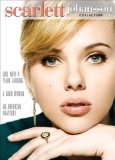| Reviews & Columns |
|
Reviews DVD TV on DVD Blu-ray 4K UHD International DVDs In Theaters Reviews by Studio Video Games Features Collector Series DVDs Easter Egg Database Interviews DVD Talk Radio Feature Articles Columns Anime Talk DVD Savant Horror DVDs The M.O.D. Squad Art House HD Talk Silent DVD
|
DVD Talk Forum |
|
|
| Resources |
|
DVD Price Search Customer Service #'s RCE Info Links |
|
Columns
|
|
|
Scarlett Johansson Collection
THE MOVIES:
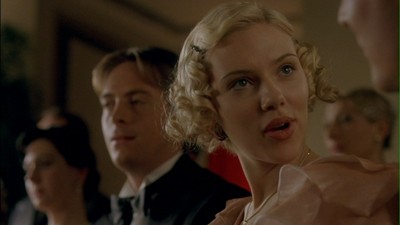
I have no problem admitting I'm a Scarlett Johansson fan. If I wasn't, I'd have been awfully stupid to sign up to review the Scarlett Johansson Collection, a new three-disc bundling of some of her older movies (two of which I have seen). If I was one of those folks who got all sour faced when her name was mentioned, it would be a long haul up that hill, let me tell you.
The funny thing is, the reason I like Ms. Johansson as an actress is often what makes other people doubt her stardom. It's also what I think attracts many of the directors who have worked with her to casting the young starlet in their films. In short, it's that Scarlett Johansson is an empty vessel. Her star persona is practically the absence of one. Beyond her immeasurable physical beauty, the actress appears to only bring to the screen what the director wishes to project on her, the role he or she intends to pour into her. This makes for some truly wonderful cinematic performances when she is working with a great director, someone like Sofia Coppola, the Coen Bros., or Woody Allen, whose adoption of Scarlett as his muse has been like Viagra for his formerly sagging career. On the other hand, put her in the hands of a Michael Bay or a Frank Miller, and the results can be terrible. Even her singing career bears this theory out, as she teamed with a high-profile producer to record Tom Waits songs, making her more of a vehicle for those two than a musical performer in her own right.
All this from an actress who is merely twenty-four, and who wasn't even twenty when the most recent of the films here was released. The movies contained in the Scarlett Johansson Collection--An American Rhapsody, Girl With a Pearl Earring, and A Good Woman--range from 2001 to 2003, and the DVDs included in the set are exactly the same as the ones that were released on their own, right down to the art on the discs. So, nothing new to buy here for those already in possession, but a compact and quick way to pick up some fairly good movies for those who aren't.
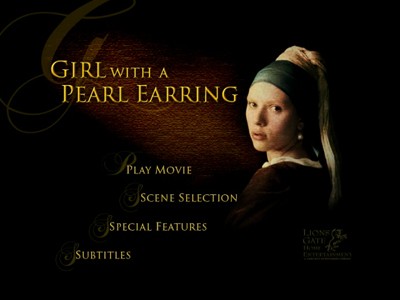
The lead film in the set, Girl With a Pearl Earring (2003; 100 minutes), followed on the heels of Scarlett's breakout role in Lost in Translation and cemented the actress' position as one to watch. The perception of her now is that she is a big star and always has been, but the truth is the actress was always drawn to more independently minded, adventurous productions, and those have tended to work out for her better than parts in big-budget candy like The Nanny Diaries.
Girl With a Pearl Earring works as a great illustration of my theory: Scarlett Johansson as the artistic muse. In this period movie set in 17th-century Holland, she plays Griet, a pious young woman sent to work as a maid in an upper-class household in order to support her family. Ironically for a girl whose father has gone blind painting decorative tiles, Griet is sent to serve in the home of Johannes Vermeer (Colin Firth), the famous artist known for his attention to textural detail and the affects of light (among other things). Griet enters into a kind of mini-society within society, a matriarchy where she is the bottom rung and must suffer the scorn of the grandmother, mother, and child alike. At seventeen, Griet has seen nothing of the world. The butcher's boy (Cillian Murphy) is her first courtship, and Vermeer's saucy patron (Tom Wilkinson) is her first experience of truly loose morals.
Yet, the girl already has a taste for art, treasuring a title given to her by her father, and her first glimpses of Vermeer's work touch her. Call her an empty vessel or a blank canvas, but Griet is not just an object now for the artist to look upon, but she is also an open set of eyes ready to see what the painter is willing to show her. Possessed of a preternatural sense of color, composition, and an understanding of how light works, she provides an understanding ear for the artist (Firth is at his moody, broody best) and eventually a source of inspiration. Despite the marketing campaign that would have you believe Vermeer will also bed his subject, this is not true. Though the artist/model relationship has its sensual moments, Girl With a Pearl Earring--directed by Peter Webber and adapted from a novel by Tracy Chevalier--is more about the connection between individuals and art, the sacrifices one makes to maintain a persistence of vision and follow the creative impulses that compel them. Though bundled up by religious and social convention, when peering into Vermeer's paintings, Griet finds a place where none of that holds sway.
I don't think there is another movie where Scarlett Johansson is this quiet, where observation is her main course of action. Some of the best moments of the film are when Webber lingers on her face as she stares at one of Vermeer's canvases, capturing the reactions in her wide green eyes. Likewise, the film's most stirring scene is when Vermeer poses her, instructing her how to tilt her head, what to do with her mouth. It's intimate and soulful, and yet she barely speaks.
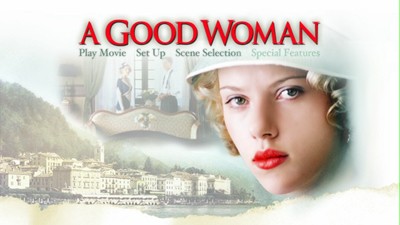
For 2004's A Good Woman (93 mins.), Scarlett is less the focal character and more a part of the supporting ensemble. She plays Meg, the naïve newlywed on an extended stay in Italy with her husband Robert Windermere (Mark Umbers). Robert becomes embroiled in gossip regarding Mrs. Erlynne (Helen Hunt), a woman of loose morals known to steal many a husband. If this rumored affair is true, it would be a perfect development for the cad Lord Darlington (Stephen Campbell Moore), who has designs on stealing Meg for his own. Meanwhile, the wags also doubt the success of the twice-married Lord Tuppy (Wilkinson again) in his own affair with Mrs. Erlynne. Little do they know how much more scandalous the truth actually is and the comical yet potentially devastating consequences that could arise if Mrs. Erlynne can't prevent Meg from throwing her marriage away over idle chatter.
A Good Woman is based on the Oscar Wilde play Lady Windermere's Fan. Screenwriter Howard Himelstein (My Sexiest Year) has transplanted the tale from the late 19th century to the depression era, meaning the lads and ladies alike can wear kicky jazz-age fashions. Director Mike Barker gives the movie a nice sparkle without letting the period style overshadow the writing, which largely plays on dialogue and many of Wilde's more famous turns of phrase. It's a solid production, entertaining even on a second view, so why doesn't A Good Woman stick in my head more? Is it too slick a trifle for its own good?
The acting is by and large quite excellent. Only Mark Umbers appears out of his league playing the big American lunkhead. For those who think Scarlett Johansson is shallow, she looks like a snapshot of the Mariana Trench standing next to him. As Meg, she is innocent and girlish and charming (note her body language particularly in the bedroom scenes, like when she receives the gift of the fan), and at times, she maybe goes too far into those waters, the character's inexperience starting to look a little like acting inexperience. Yet, there is a design to the role that shows Meg growing more confident through the play's four acts, and Scarlett makes the shift convincing. On the other side of the age divide, Tom Wilkinson is dashing and self-assured, while Helen Hunt brings real nuance to her role, showing the weary years of paying the price of getting what she wanted in the ways that Mrs. Erlynne has.
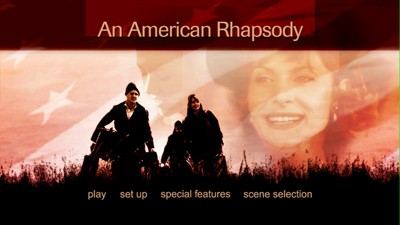
The oldest and probably least well-known film in the Scarlett Johansson Collection is Éva Gárdos' autobiographical An American Rhapsody (2001; 106 mins.). The story spans fifteen years and multiple countries, starting in the early 1950s in Hungary and moving all the way to the U.S. in 1965. A Hungarian couple, Peter and Margit (Tony Goldwyn and Nastassja Kinski), are fleeing Budapest, but they are only allowed to take one of their children. Their youngest daughter, Suzanne, is just a baby and must be smuggled to them by separate means. When Margit's mother (Ágnes Bánfalvy) gets a bad feeling about the woman who is going to do the job, however, she balks at surrendering Suzanne.
It takes another six years to get Suzanne to America, and by then she has bonded with the family that has cared for her and is too young to understand what is happening to her when she is shipped off to California to join her birth family in their new life. Even by the time she is a rebellious fifteen-year-old, Suzanne (now played by Johansson) has not been able to reconcile the lifestyle change. She doesn't get along with her mother and doesn't understand why she had to leave one place behind for another. Only a trip back to her homeland will show her the truth.
For those watching An American Rhapsody for Scarlett Johansson, you're going to have to wait an hour before she shows up (minus the brief introductory scene at the start of the picture). The first half of the film deals with the flight from Hungary (shown in black-and-white, though the green tint in some shadows makes me think not shot in black-and-white), the time apart (split between California and Budapest), and Suzanne's eventual flight across the world and her difficulty adjusting. The second half is her adolescent acting out and the return to Europe. The film is a well-told coming-of-age tale with a unique twist, the story of the reluctant immigrant. Gárdos has done an excellent job relating what it was like to be young and to have your whole life uprooted while still paying all due respect to the dangerous journey and sacrifices the older people in her lives undertook. When Suzanne returns to Hungary, the writer/director creates a nice contrast between life there and the more modern/free life the girl has in the U.S. And again, in these scenes, Johansson's talents as an observer serve her well, particularly in a silent montage where she travels the city's streets on her own.
As a growing girl, Scarlett Johansson does an excellent job. She's slightly gawky, a whole lot bratty, but most importantly, appropriately irrational and emotional. The rest of the cast is also really good. Nastassja Kinski as the concerned mom and Tony Goldwyn as the stalwart dad give two of the best performances of their careers, never overdoing it with the accents or the emotional histrionics. In fact, the whole of An American Rhapsody has a calm, subdued air that lends it an easy credibility.
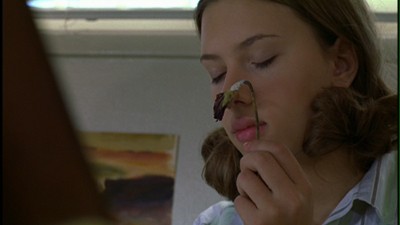
THE DVD
Video:
As noted prior, the Scarlett Johansson Collection repackages three DVDs that have been available as individual releases for the last several years. Nothing has been done to alter them in any way, the DVDs have merely been shuffled from one outer shell to another.
All three movies boast anamorphic widescreen transfers in their correct aspect ratios (Girl is 2.35, the others 1.85), and all are actually strong efforts, representing the best of the technology at the time. I noticed some grain in Girl With a Pearl Earring that may not have been entirely intentional, and there is some minor edge enhancement in An American Rhapsody, but all three transfers have excellent colors and very little by way of pixilation or other digital errors. Very good for DVDs that are all around five years old.
Sound:
All three movies get competent 5.1 Dolby mixes on their original soundtracks. Both Girl and Good Woman also have English and Spanish subtitles, while An American Rhapsody only has English.
Extras:
The Scarlett Johansson Collection mirrors the packaging on many of the other Lions Gate actor and director sets. The three discs are in a standard-sized plastic case with a hinged double-sided tray. The set also has a cardboard slipcover.
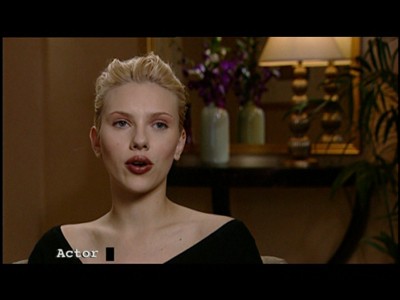
All three movies had bonus features on their initial releases, and those are all maintained here.
Girl With a Pearl Earring has a collection of trailers, an inexplicable and anonymous music video featuring Scarlett Johansson and the Vermeer painting (this one is so bad, they didn't even list it on the packaging this time around), and an episode of Sundance's "Anatomy of a Scene" focused on the movie (runs about 27 minutes).
A Good Woman also has trailers, as well as a commentary by director Mike Barker and producer Alan Greenspan. Outside of a few noticeable moments of silence, the pair manage to keep the commentary moving and give some insight into how the production went down, showing their pride in their work.
Finally, An American Rhapsody has its own theatrical trailer alongside a commentary by writer/director Éva Gárdos and producer Colleen Camp. As the two have had a long and fruitful relationship, they also have a good rapport here, making for a chatty and informative commentary. Camp also plays one of the American neighbors in the movie.
FINAL THOUGHTS:
Highly Recommended. Though not the best movies she's been in, the 3-disc Scarlett Johansson Collection does bring together three underappreciated selections from the actress' early 21st-century career. Both the Oscar Wilde-adaptation, A Good Woman, and the mid-20th century immigrant story, An American Rhapsody, seem to have been largely forgotten, and that's too bad, because they are both well-made films. The one true stand-out of the set, however, is Girl With a Pearl Earring. Telling an imaginary story of the painter Johannes Vermeer (Colin Firth) and the young maid who inspired one of his most famous masterworks, the movie gives Johansson an ideal opportunity to show what a soulful and interior actress she can be. Thus, even though the Scarlett Johansson Collection offers nothing new in terms of the individual discs, it may offer a couple of films you've never seen before in one handy package.
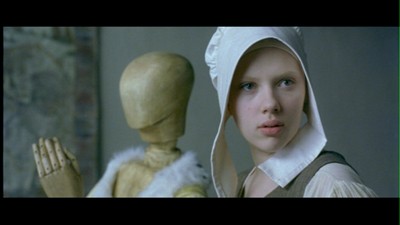
Jamie S. Rich is a novelist and comic book writer. He is best known for his collaborations with Joelle Jones, including the hardboiled crime comic book You Have Killed Me, the challenging romance 12 Reasons Why I Love Her, and the 2007 prose novel Have You Seen the Horizon Lately?, for which Jones did the cover. All three were published by Oni Press. His most recent projects include the futuristic romance A Boy and a Girl with Natalie Nourigat; Archer Coe and the Thousand Natural Shocks, a loopy crime tale drawn by Dan Christensen; and the horror miniseries Madame Frankenstein, a collaboration with Megan Levens. Follow Rich's blog at Confessions123.com.
|
| Popular Reviews |
| Sponsored Links |
|
|
| Sponsored Links |
|
|
| Release List | Reviews | Shop | Newsletter | Forum | DVD Giveaways | Blu-Ray | Advertise |
|
Copyright 2024 DVDTalk.com All Rights Reserved. Legal Info, Privacy Policy, Terms of Use,
Manage Preferences,
Your Privacy Choices | |||||||









